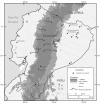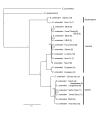Cryptic diversity and deep divergence in an upper Amazonian leaflitter frog, Eleutherodactylus ockendeni
- PMID: 18154647
- PMCID: PMC2254618
- DOI: 10.1186/1471-2148-7-247
Cryptic diversity and deep divergence in an upper Amazonian leaflitter frog, Eleutherodactylus ockendeni
Abstract
Background: The forests of the upper Amazon basin harbour some of the world's highest anuran species richness, but to date we have only the sparsest understanding of the distribution of genetic diversity within and among species in this region. To quantify region-wide genealogical patterns and to test for the presence of deep intraspecific divergences that have been documented in some other neotropical anurans, we developed a molecular phylogeny of the wide-spread terrestrial leaflitter frog Eleutherodactylus ockendeni (Leptodactylidae) from 13 localities throughout its range in Ecuador using data from two mitochondrial genes (16S and cyt b; 1246 base pairs). We examined the relation between divergence of mtDNA and the nuclear genome, as sampled by five species-specific microsatellite loci, to evaluate indirectly whether lineages are reproductively isolated where they co-occur. Our extensive phylogeographic survey thus assesses the spatial distribution of E. ockendeni genetic diversity across eastern Ecuador.
Results: We identified three distinct and well-supported clades within the Ecuadorean range of E. ockendeni: an uplands clade spanning north to south, a northeastern and central lowlands clade, and a central and southeastern clade, which is basal. Clades are separated by 12% to 15% net corrected p-distance for cytochrome b, with comparatively low sequence divergence within clades. Clades marginally overlap in some geographic areas (e.g., Napo River basin) but are reproductively isolated, evidenced by diagnostic differences in microsatellite PCR amplification profiles or DNA repeat number and coalescent analyses (in MDIV) best modelled without migration. Using Bayesian (BEAST) and net phylogenetic estimates, the Southeastern Clade diverged from the Upland/Lowland clades in the mid-Miocene or late Oligocene. Lowland and Upland clades speciated more recently, in the early or late Miocene.
Conclusion: Our findings uncover previously unsuspected cryptic species diversity within the common leaflitter frog E. ockendeni, with at least three different species in Ecuador. While these clades are clearly geographically circumscribed, they do not coincide with any existing landscape barriers. Divergences are ancient, from the Miocene, before the most dramatic mountain building in the Ecuadorean Andes. Therefore, this diversity is not a product of Pleistocene refuges. Our research coupled with other studies suggests that species richness in the upper Amazon is drastically underestimated by current inventories based on morphospecies.
Figures


References
-
- Vellend M, Geber MA. Connections between species diversity and genetic diversity. Ecol Lett. 2005;8:767–781. doi: 10.1111/j.1461-0248.2005.00775.x. - DOI
-
- Duellman WE. Patterns of Distribution of Amphibians: a global perspective. Baltimore: The Johns Hopkins University Press; 1999.
Publication types
MeSH terms
Substances
LinkOut - more resources
Full Text Sources

